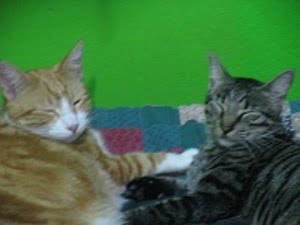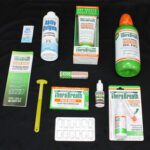No doubt you’ve heard the old saying “Knowledge is power.” This is certainly true when it comes to caring for cats.
Here are five common ailments you need to look out for if you love your cat.
- 1. Gingivitis. Also known as gum disease. Dry cat food often contains carbohydrates, and this increases your cat’s risk of getting gingivitis. Here’s what happens according to this article, written by Kathy Blumenstock.
If your cat has reddened gums, stinky breath, and has trouble chewing food, it’s very likely it has gingivitis, and if so, this can become a serious health problem for your cat if left untreated.
The bacteria can spread from the gums into the blood stream and cause kidney damage, she writes.
What’s the best way to prevent this? First, a trip to the vet is in order. If your kitty does have gingivitis, it’s likely your cat’s teeth will need to be cleaned professionally. The veterinarian may also prescribe an antibiotic to treat the gingivitis, according to Blumenstock.
You can keep gingivitis from returning by giving your cat’s teeth a daily brushing, using toothpaste that’s formulated for cats, she added, noting that vets also carry special dental formula dry cat food, and this will also help to keep your cat’s teeth and gums strong.
- 2. Worms. Even an indoor cat can get worms. Roundworms are common. Cats contract them by eating infected rodents, birds, or insects, or by coming into contact with contaminated soil, Blumenstock writes. The roundworms then wind up in a cat’s intestines and use the bloodstream to migrate to other organs.
If your cat has a distended belly, dull fur, a lack of appetite, spaghetti-shaped strings in her poop or vomit, she may likely be infested with these parasites. It’s something to take note of, because a large roundworm infestation can kill a kitten, Blumenstock reports.
Tapeworms are another common parasite cats have to deal with. The eggs of these ribbon-shaped parasites are ingested by fleas. If your cat accidentally swallows the fleas, the larvae then hatch in your cat’s stomach and attach themselves to the walls of the small intestines, sapping up nutrients that should be going to your cat, she writes.
Cats with a large infestation will lose weight and suffer mild diarrhea.
Rice-shaped grains around your cat’s anus and in her poop are a sure sign of tapeworm.
Fortunately, it’s easy to get rid of these little naughty no-nos. You can purchase oral deworming medication at your vet’s.
Blumenstock added that the best remedies for keeping parasites out of the question are: cleanliness, flea control, and keeping your cat inside, out of harm’s way.
- 3. Upper respiratory diseases. Remember the last time you caught a cold because your husband caught a cold and gave it to your kids and then they gave it to you? This happens to cats, too. Their respiratory ailments are frequently caused by viruses and bacteria that may invade a cat’s nose, throat, and sinuses, Blumenstock writes.
If you have more than one cat when these illnesses are making the rounds, you may be in for a challenging time.
URIs can be spread when cats share food and water dishes, when they sneeze, or when they groom each other, she added.
To make matters worse, secondary bacterial infections may gang up on your cat as well and stress and overcrowding may also be contributing factors.
The most contagious URIs are the Feline Calici virus and the feline herpes virus.
Symptoms:
If your cat has these symptoms it’s time for a trip to the vet. The likely course of action will be antibiotics, rest and isolation, as well as plenty of fluids for your cat, the site reports.
Kittens are the most at risk, especially if they haven’t had all of their vaccinations.
When it comes to preventing URIs, the best offense is a good defense. Keep your cats inside, to keep them separated from other cats, keep stress levels down, make sure they are up-to-date on vaccines and that they receive regular examinations from the vet to keep their immune system up to snuff.
- 4. Feline Diabetes. Cats and humans can suffer from diabetes. Like us, cats can get both forms of the disease. In type 1 diabetes, the pancreas doesn’t produce enough insulin. In type 2, the necessary cells in the body don’t respond appropriately to insulin.
Your cat will need to be monitored frequently by a veterinarian in both stages of this dangerous disease.
This article, by Sandy Eckstein, points out the symptoms of feline diabetes.
In people and cats, insulin is a hormone that’s produced by the pancreas. When your cat eats, food is broken down and forms organic compounds. Glucose is one of these compounds. Cells use glucose for energy, growth and repair, according to Cat World
If the pancreas is functioning correctly, it produces the right amount of insulin, which then attaches to cell walls, enabling the glucose to move into the cells.
In diabetic cats, either the quality or the activity of the insulin is reduced and tissues aren’t able to utilize the insulin. Glucose winds up in the bloodstream, causing the cat to develop hyperglycemia (high blood sugar). It also winds up in the urine, the site reports.
If this goes untreated, the cat’s body will break down its own fat and protein to use for energy.
What tests will my vet do to see if my cat has diabetes? It’s likely the vet will conduct a physical examination, as well as urine tests and several blood tests Cat World reports.
This is because blood tests show higher levels of glucose when a cat is stressed.
Overweight, middle-aged or older cats are most at risk for diabetes.
If your cat is diagnosed with a mild case, you may be able to manage the illness by changing her diet and helping her lose weight, all under the guidance of your vet.
If the diabetes is more serious, your cat may need insulin injections, usually once or twice per day, the site reports. The injections are given under the skin of the neck. The veterinarian will need to monitor your cat frequently, as her insulin levels may need to be adjusted.
For information regarding caring for a diabetic cat, click here.
This site also has useful information about diet and medications, as well as potentially serious complications that may affect your cat.
A diabetic cat can live for many years if the disease is managed properly. Occasionally diabetes resolves itself over time.
- 5. Feline Lower Urinary Tract Disease (FLUTD). This nasty ailment, which afflicts male cats more often than it does females, occurs in the bladder and the urethra (the tube that carries urine from the bladder to the outside).
To find out the causes of FLUTD, read here .
One complication of FLUTD may be Cystitis,
Cystitis is a potentially life-threatening illness. Call your vet immediately, whether it’s day or night.
If your cat has this, he may strain while trying to urinate and meow in pain. Here’s how to help your cat.
Upon examination, the vet may find that the walls of your cat’s bladder have thickened, or that the urine may be blocked. A urinalysis may show that there are urine crystals in the bladder. Blood is commonly found in the cat’s urine.
With the prescription of medication and a change in your cat’s diet, the infection should go away within 10 days. Your vet will likely conduct several urinalysis tests to monitor blood in your cat’s urine.
These illnesses are common, but they are conquerable. These guidelines will keep your cat on the road to good health.






